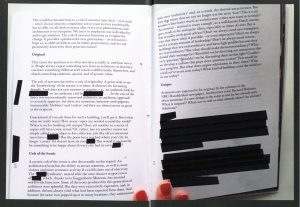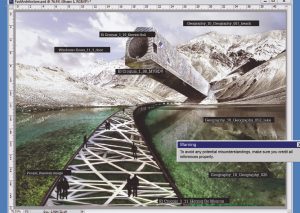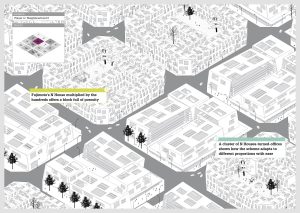Winy Maas and Felix Madrazo
nai010 publishers

According to Hillel Schwartz, the act of copying lies at the core of our existence as humans: “Copying is pedestrian. Copying is peculiar. On the one hand, copying makes us what we are. Our bodies take shape from the transcription of protein templates, our languages from the mimicry of privileged sounds, our crafts from the repetition of prototypes. Cultures cohere in the faithful transmission of rituals and rules of conduct. To copy, cell for cell, word for word, image for image, is to make the known world our own.”1 For Winy Maas and Felix Madrazo, editors of Copy Paste, this act also lies at the heart of architectural practice. Traditionally, the goal of architectural training was to develop the student’s awareness and proficiency with the laws of composition and related systems used in its generation (e.g., rituals, dimensions, proportions, and ornaments). “To master Copy Paste was as important for the architect, in traditional architectural discourse, as his ability to innovate” (98). J. N. L. Durand’s Précis, for example, was one of many sourcebooks meant to systematize general architectural principles from specific cases in order to extract their essence for implementation to future projects.2 Copying within certain parameters was the norm.
Early twentieth-century modernism expanded its sphere of references by looking outside the discipline for inspiration on materiality, composition, representation, and general principles of architectural organization. For example, Beatriz Colomina explained the connection of medical imagery to early twentieth-century modernism, stating that “as medical representations changed so did architectural representations. In the 20th century, it was the widespread use of the X-ray that made a new way of thinking about architecture possible.”3 The expansion of references and perceived freedom of personal expression fed a desire within the architect to be a purveyor of original architectural compositions, perpetuating a culture of newness. Postmodernism and the more recent explorations of a post-digital crowd have sought to perpetuate a culture of newness while again harvesting historical precedence for latent qualities. Even the most recent Chicago Biennial, curated by Mark Lee and Sharon Johnston, challenged participants to “Make New History.” In an interview about the curatorial theme, Lee stated, “That is exactly why we think history is more important and relevant than ever. Perhaps unlike historicism, where things are subsumed under a grand historical narrative structure, we see history as a horizon, open and accessible, with multiple entry and exit points.4
Copy Paste champions the design of architecture that builds on the past to increase the degree of innovation in the present. The inside cover offers a “Copy and Evolution” dedication proclaiming that “at a time when everything seems to be collaged out of everything else, the architect’s obsession with being original is becoming increasingly obsolete.” The editors suggest a manner much more blatant in its direct referential likeness. Maas, co-founding director of MVRDV, begins the book with an opportune approach, recycling a previous version of an older text to refine it—in this case, through redaction (Figure 1). In it, he states, “People are always expecting something new from us architects, so they can have something different with which to differentiate themselves, and obtain something authentic, special, and of greater value. The cult of newness has led to a cult of originality” (10). The series of texts that follow this brief introduction address a range of issues around the act of copying/pasting architecture, including similarity, originality, typology, genealogy, fakery, copyright law and patents, and information overload in a digital culture. These texts are mirrored into two categories, “Copy/Paste” and “Paste/Copy,” and they are bifurcated by a “Copy Guide” wherein the members of The Why Factory illustrate how to deploy some of the techniques being advocating.
A common theme throughout the book is the connection of the prosaic digital commands “copy” and “paste” to historical and contemporary attitudes. Petra Brower and Matteo Kuijpers lament “the loss of [a] Copy Paste culture,” calling it “one of the twentieth century’s architectural tragedies” (102), and Aaron Betsky encourages a hunter-gatherer approach, suggesting “to make architecture in the same way we create most of our images, objects and spaces today: by collecting what already exists, using digital technology to assemble, reform or deform those existing materials, to make something out of what exists while opening new perspectives within that material range” (88).

In the “Copy Guide,” the editors transition from theory to application. Tutors and students from the Why Factory set out to test their ideas through several exercises, including the development of architectural compositions through the curation of an image archive (“Photo-Chopped”; Figure 2), the creation of an architectural publication based on the format of El Croquis (“El Croquet”; Figure 3), and a gameboard approach to urban planning (“Game of Clones”; Figure 4). As a testament to the book’s title, the authors have organized this section in a manner that is easily duplicated, making the book an instructive and provocative companion to the design studio.

Figure 2. “Photo-Chopped”: The Why Factory exercise investigating the sampling and collaging of existing imagery in the generation of new architectural compositions. Image Credit: Maas, Winy and Felix Madrazo, eds. Copy Paste: The Badass Architectural Copy Guide. Rotterdam, Netherlands: nai010 publishers, 2018.


The strength of this book lies in its accessibility and relevance to contemporary design studios both academic and professional, although the format of dissemination through print suppresses its potential to respond to a topic that changes so quickly. Designers are perpetually bombarded with architectural content through numerous online platforms, and images are consumed at a rate that challenges consumers to retain more than the splash image intended to garner hits or likes. Student design proposals become a mashup of sources without awareness of their lineage, while the professional architect negotiates between desired novelty and an increased pace of professional practice. Additionally, contemporary digital design exists in a situation where generative files are shared extensively, and original authors and/or sources are rarely known or cited. Copy Paste offers a respite from the fatigue created by the cult of originality and instead celebrates transparency in the sampling of content.
As an edited collection situated for both theory and application, Copy Paste is not a linear read but rather a robust assemblage of content collectively positing a convincing argument for an aggressive approach to the use of precedent in architectural design. At times, the strategies seem to be rogue, perhaps nodding to hip-hop culture of the 1980s and ’90s, where content was used without remorse. At other times, application of the methods is more akin to a scientific approach where phenotypes are measured and charted in reference to the controlled and predictable characteristics of the genotype. In either case, the thesis of the book is a fresh approach to composition that does not seek to hide its sources for the sake of a perceived novelty but rather celebrates the genealogy of references to foster innovation through evolution.
Endnotes:
Brian M. Kelly, AIA, is an NCARB-certified, licensed architect in the State of Nebraska and an associate professor of architecture in the College of Architecture at the University of Nebraska at Lincoln (UNL). Prior to joining the faculty at UNL, Brian was lead designer in the office of Randy Brown Architects, designing several award-winning projects of various types and scales. His previous teaching experience includes Drury University’s Hammons School of Architecture in Springfield, MO, and the California Polytechnic State University in San Luis Obispo. Brian’s teaching focus is in the areas of beginning design, design thinking, architectural representation theory, and the threshold between making and marking. His students’ work has been featured in academic journals, and his professional work has been published internationally.
How to Cite This: Kelly, Brian M. Review of Copy Paste: The Badass Architectural Copy Guide, by Winy Maas and Felix Madrazo, eds. JAE Online. December 6, 2019. http://www.jaeonline.org/articles/review/copy-paste#/.






